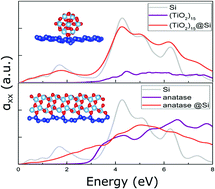Silicene-supported TiO2 nanostructures: a theoretical study of electronic and optical properties†
Abstract
Titania (TiO2) is a material of choice for energy-related applications, such as photovoltaics and photocatalysis. The presence of a large band gap and fast electron–hole recombination occurring in the lattice significantly reduce the material's quantum efficiency, and therefore limit industrial-scale applications. In this article, we investigate whether silicene can be a viable substrate for TiO2 nanostructures in photocatalytic applications. Calculations based on density functional theory find a strong electronic coupling between silicene and oxide nanostructures. Electron transfer from silicene to the nanostructures results in the production of active photoreduction sites involving Ti3+ ions in the system. The hybrid TiO2/silicene system also exhibits modification of optical characteristics with the capability of absorbing light in the visible range and spatially separating charges, thus displaying superior photocatalytic activity relative to pristine TiO2 for energy-related applications.



 Please wait while we load your content...
Please wait while we load your content...